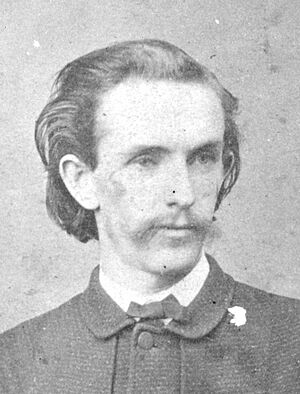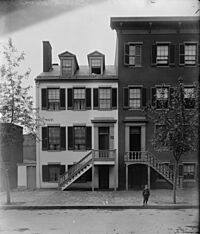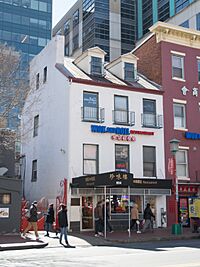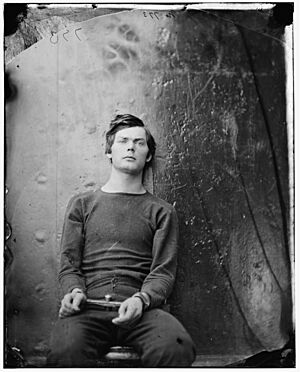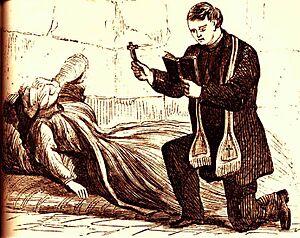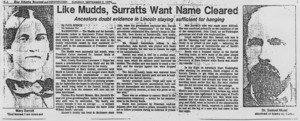Mary Surratt facts for kids
Quick facts for kids
Mary Surratt
|
|
|---|---|
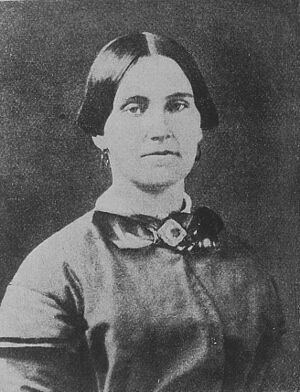
Surratt, c. 1860-65
|
|
| Born |
Mary Elizabeth Jenkins
1820 or May 1823 Waterloo, Maryland, U.S.
|
| Died | July 7, 1865 (aged 42 or 45) |
| Cause of death | Execution by hanging |
| Resting place | Mount Olivet Cemetery |
| Nationality | American |
| Occupation | Boarding house and tavern owner |
| Known for | Being convicted as a conspirator in the assassination of Abraham Lincoln |
| Criminal status | Executed (July 7, 1865) |
| Spouse(s) |
John Harrison Surratt
(m. 1840; died 1862) |
| Children | Isaac (b. 1841; died 1907) Elizabeth Susanna "Anna" (b. 1843; died 1904) John Jr. (b. 1844; died 1916) |
| Conviction(s) | Conspiracy to assassinate Abraham Lincoln |
| Criminal penalty | Death |
| Partner(s) |
|
|
Date apprehended
|
April 17, 1865 |
Mary Elizabeth Jenkins Surratt (born in 1820 or 1823 – died July 7, 1865) was an American woman who owned a boarding house in Washington, D.C.. She was found guilty of being part of the plot to kill U.S. President Abraham Lincoln in 1865.
She was sentenced to death and became the first woman executed by the U.S. federal government. Mary Surratt always said she was innocent. The decision to find her guilty is still debated today. She was the mother of John Surratt, who was also tried for the plot but was not found guilty.
Mary Surratt was born in Maryland in the 1820s. She became a Catholic when she was young and remained one her whole life. In 1840, she married John Harrison Surratt. They had three children together. Her husband, John, owned a tavern, an inn, and a hotel. The Surratt family supported the Confederate States of America and often welcomed other Confederate supporters at their tavern.
After her husband died in 1862, Mary Surratt moved to her townhouse in Washington, D.C. She turned it into a boarding house. There, she met John Wilkes Booth, who later killed President Lincoln. Booth visited her boarding house many times. Other people involved in the assassination plot, like George Atzerodt and Lewis Powell, also visited.
Just before Lincoln was killed, Booth spoke with Mary Surratt. He gave her a package of binoculars for one of her tenants, John M. Lloyd. After Lincoln was assassinated, Mary Surratt was arrested. She was tried by a military court the next month, along with the other people accused in the plot.
She was found guilty mainly because of what John Lloyd said. He claimed she told him to have "shooting irons" (guns) ready. Another person, Louis J. Weichmann, also testified about Mary Surratt's connections with Booth. Five of the nine judges asked President Andrew Johnson to spare her life because of her age and gender. However, Johnson did not grant her mercy. Mary Surratt was hanged on July 7, 1865. She was later buried in Mount Olivet Cemetery.
Contents
Mary Surratt's Early Life
Mary Elizabeth Jenkins was born near Waterloo, Maryland, which is now known as Clinton. She was born on a tobacco farm. Some records say she was born in 1820, while others say May 1823.
Mary had two brothers, John and James. Her father died in 1825 when Mary was very young. Her mother then inherited their property.
Even though her father was a Protestant and her mother was Episcopalian, Mary was sent to a private Roman Catholic girls' school. This school was called the Academy for Young Ladies in Alexandria, Virginia. She started there on November 25, 1835. Her aunt, Sarah Latham Webster, was Catholic, which might have influenced this choice. Within two years, Mary became a Roman Catholic. She stayed at the school for four years, leaving in 1839 when it closed. She remained a devoted Catholic for the rest of her life.
Mary Surratt's Family Life
Mary Jenkins met John Harrison Surratt in 1839. She was 16 or 19, and he was 26. John's family had lived in Maryland since the late 1600s. He was an orphan and was adopted by a wealthy couple, Richard and Sarah Neale. The Neales owned a farm in Washington, D.C. John inherited part of this farm.
Mary and John married in August 1840. John became a Catholic before their marriage. They might have married in a Catholic church in Washington, D.C. John bought a mill in Oxon Hill, Maryland, and they moved there. They had three children: Isaac (born 1841), Elizabeth Susanna, called "Anna" (born 1843), and John Jr. (born 1844).
In 1843, John Surratt bought more land from his adoptive father. This land was on the border between D.C. and Maryland. In 1845, John and Mary moved back to John's childhood home to help his mother with the farm. But John's mother, Sarah Neale, died in August 1845. She had given the rest of the farm to John before she passed away.
Mary Surratt helped raise money to build St. Ignatius Church in Oxon Hill. It was built in 1850. However, John became unhappy with his wife's religious activities. His behavior got worse over the next few years. John often did not pay his debts, and he became very angry and violent.
In 1851, the Neale farmhouse burned down. An escaped family slave was thought to have started the fire. John found work on the Orange and Alexandria Railroad. Mary and her children moved in with her cousin, Thomas Jenkins, in nearby Clinton. Within a year, John bought more farmland near Clinton. By 1853, he built a tavern and an inn there. Mary first refused to move into the new home. She stayed on the old Neale farm. But John sold both the Neale farm and his other land in May 1853 to pay debts. Mary was then forced to move back in with him in December.
With the money from the tavern and his land sales, John Surratt bought a townhouse in Washington, D.C., on December 6, 1853. He started renting it out to people. In 1854, John built a hotel next to his tavern and called it Surratt's Hotel.
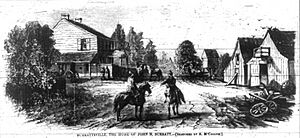
The area around the tavern was officially named Surrattsville that same year. Travelers could go north to Washington, D.C., southwest to Piscataway, or northeast to Upper Marlboro. Surrattsville was a well-known crossroads, but it was a small community. It had the tavern, a post office (inside the tavern), a forge, and a few houses. John Surratt was the first postmaster there.
John expanded his family's property by selling land, paying debts, and starting new businesses. Over the next few years, he acquired or built a carriage house, corn crib, general store, forge, granary, gristmill, stable, tobacco curing house, and a wheelwright's shop. The family had enough money to send all three children to Catholic boarding schools. Isaac and John Jr. went to the school at St. Thomas Manor. Anna went to the Academy for Young Ladies, where her mother had studied.
However, the family's debts continued to grow. John sold more land in 1856 to pay debts. By 1857, Surratt had sold most of the family's large land holdings. Most of the family's slaves were also sold to pay debts. In 1860, St. Thomas Manor School closed. Isaac found work in Baltimore, Maryland. The Surratts sold more land. This allowed Anna to stay at her school and John Jr. to go to St. Charles College, Maryland. The couple also borrowed money against their townhouse in Washington, D.C.
Life During the Civil War
The American Civil War started on April 12, 1861. Maryland, a border state, stayed with the United States (the Union). However, the Surratts supported the Confederacy. Their tavern often hosted other Confederate supporters. The Surratt tavern was used as a safe house for Confederate spies. Mary likely knew about this. A Confederate scout and spy named Thomas Nelson Conrad visited Surratt's boarding house often.
On March 7, 1861, Isaac, Mary's son, left Maryland and went to Texas. He joined the Confederate States Army. John Jr. left school in July 1861. He became a messenger for the Confederate Secret Service. He carried messages, money, and illegal goods across enemy lines.
The Confederate activities around Surrattsville caught the attention of the Union government. In late 1861, Lafayette C. Baker, a detective for the Union Intelligence Service, and 300 Union soldiers camped in Surrattsville. They investigated the Surratts and others for Confederate activities. He found evidence of a large Confederate messenger network. Even with some arrests, the network continued.
John Surratt Sr. suddenly died on August 25 or 26, 1862, from a stroke. The Surratt family was in serious financial trouble. John Jr. and Anna both left school to help their mother manage the family's farm and businesses. On September 10, 1862, John Jr. became the postmaster of the Surrattsville post office. Lafayette Baker returned to Surrattsville in 1862. Several postmasters were fired for disloyalty, but John Jr. was not.
In August 1863, John Jr. tried to get a job in the United States Department of War. But his application made federal agents suspicious about his family's loyalty to the Union. On November 17, 1863, he was fired as postmaster for disloyalty.
Losing John Jr.'s job caused a financial crisis for the Surratt family. By 1864, Mary Surratt found that her husband's unpaid debts and bad business deals left her with many people she owed money to. Several of her slaves ran away. When her son was not meeting with Confederate supporters, he was selling vegetables to earn money for the family. Mary was tired of running the farm, tavern, and other businesses without her son's help. In the fall of 1864, she started thinking about moving to her townhouse in the city.
On October 1, 1864, she took possession of the townhouse at 604 H Street NW in Washington, D.C. The house had four stories. The first floor had a kitchen and dining room. The second floor had parlors, with Mary Surratt's bedroom in the back. The third floor had three rooms, and the fourth floor (attic) had two large rooms and one small room for a servant.
Mary Surratt started moving her things into the townhouse that month. On November 1, 1864, Anna and John Jr. moved in. Mary Surratt herself moved into the home on December 1. That same day, she rented the tavern in Surrattsville to John M. Lloyd, a former policeman and Confederate supporter, for $500 a year. Mary Surratt advertised for people to rent rooms in the Daily Evening Star newspaper. She first said she only wanted renters she knew or who were recommended by friends. But in her ads, she said rooms were "available for 4 gentlemen."
Some historians wonder about Mary Surratt's move to the city. Historians Kate Larson and Roy Chamlee believe she might have moved to help with her and her son's spying activities. For example, John Surratt wrote to Louis J. Weichmann on September 21, 1864. He said the family's plans to move to the city were moving fast "on account of certain events having turned up." This might have been a secret message about his Confederate activities or the plot against Lincoln. Larson noted that while the move made sense for the long term, it would have cost money to move and furnish up to 10 rooms. Mary did not have this money.
Chamlee also found little economic reason for the move. He thought it would have been more profitable to rent the H Street boarding house entirely to others. During her time in the city, Mary tried to keep her daughter away from what she felt were bad influences. Mary still owed money on both the tavern and the townhouse. She took out another loan against the townhouse in January 1865.
John Jr. gave all his ownership of the family property to his mother in January 1865. This might have been because a traitor's property could be taken away. John's spying activities were likely why he gave up his ownership. Mary might have known or suspected his reasons. If so, she would have known about the plot.
The Lincoln Conspiracy
Louis J. Weichmann moved into Surratt's boarding house on November 1, 1864. On December 23, 1864, Dr. Samuel Mudd introduced John Surratt Jr. to John Wilkes Booth. Booth then asked John Jr. to join his plan to kidnap Lincoln. Confederate agents started visiting the boarding house often. Booth visited the boarding house many times over the next few months.
George Atzerodt and Lewis Powell stayed at the townhouse for short times. Atzerodt, a friend of both John Jr. and Booth, visited the boarding house several times in early 1865. He stayed there for a few days in February 1865, but Mary Surratt asked him to leave. However, he continued to visit the townhouse often. Powell pretended to be a Baptist preacher and stayed at the boarding house for three days in March 1865. David Herold also visited the home several times.
As part of the plan to kidnap Lincoln in March 1865, John Jr., Atzerodt, and Herold hid two Spencer carbines (rifles), ammunition, and other supplies at the Surratt tavern in Surrattsville. On April 11, Mary Surratt rented a carriage and drove to the Surratt tavern. She said she went to collect money owed to her by a former neighbor. However, her tenant, John Lloyd, said that Surratt told him to get the "shooting irons" ready for pickup.
On April 14, Surratt said she would visit the family tavern in Surrattsville again to collect a debt. Shortly before she left the city, Booth visited the boarding house and spoke privately with her. He gave her a package, which later was found to contain binoculars, for Lloyd to pick up later that evening. Surratt delivered the package. According to Lloyd, she again told him to have the "shooting irons" ready for pickup and gave him the wrapped package from Booth.
Booth's plan was to kill Lincoln. He also planned for Atzerodt to kill Vice President Andrew Johnson and Powell to kill Secretary of State William H. Seward. Booth killed Lincoln. Atzerodt never tried to kill Johnson. Powell stabbed Seward many times but failed to kill him. As they ran from the city after Lincoln's assassination, Booth and Herold picked up the rifles and binoculars from Surratt's tavern. Lloyd fixed a broken spring on Surratt's wagon before they left.
Arrest and Imprisonment
Around 2 a.m. on April 15, 1865, police officers from Washington, D.C., visited the Surratt boarding house. They were looking for John Wilkes Booth and John Surratt. It's not completely clear why the police came to the house. Most historians believe that Louis J. Weichmann's friend, Daniel Gleason, told federal authorities about Confederate activity at the Surratt house.
Within 45 minutes of the attack on Lincoln, John Surratt's name was linked to the attack on Secretary of State William H. Seward. The police and the military police had files on John Surratt Jr. and knew he was a close friend of Booth. Mary lied to the detectives, saying her son had been in Canada for two weeks. She also did not say that she had delivered a package to the tavern for Booth just hours earlier.
On April 17, a neighbor of the Surratts told U.S. military authorities that he heard one of the Surratt's servants say that three men had come to the house on the night Lincoln was killed. The servant said one of the men mentioned Booth in a theater. (The servant was wrong about the date, as John Surratt Jr. was in Elmira, New York, on a mission for a Confederate general). Other information also pointed to the boarding house as a key meeting place for the possible plotters.
Federal soldiers visited the Surratt boarding house again late on the evening of April 17. John Jr. could not be found. But after searching the house, the agents found a picture of Booth in Mary's room, hidden behind another photo. They also found pictures of Confederate leaders, a pistol, a mold for making bullets, and percussion caps. As Mary was being arrested for helping in the plot to kill Lincoln, Powell appeared at her door in disguise. Mary Surratt denied knowing him. But Powell claimed he was a laborer hired by Surratt to dig a ditch the next morning. This difference in stories, and Powell's very neat appearance (unlike a ditch-digger), led to his arrest. He was later identified as the man who tried to kill Secretary of State William Seward.
After her arrest, Mary Surratt was held at an annex to the Old Capitol Prison. She was then moved to the Washington Arsenal on April 30. Two armed guards stood outside her cell door until her death. Her cell was airy and larger than others. It had a straw mattress, a table, a wash basin, a chair, and a bucket. Food was served four times a day. She became weak during her time in prison. She was given a rocking chair and allowed visits from her daughter, Anna. She and Powell received the most attention from newspapers. The Northern newspapers were very critical of her. They claimed she had a "criminal face" because of her small mouth and dark eyes.
John Surratt Jr. was in Elmira at the time of the assassination. He was delivering messages for a Confederate general. After learning of Lincoln's death, he fled to Montreal, Quebec, Canada.
The Trial of Mary Surratt
The trial for the people accused in the plot began on May 9. All eight accused people were tried at the same time.
Mary Surratt was accused of helping, hiding, and advising her co-defendants. The government first tried to find lawyers for her and the others. But almost no lawyers wanted to take the job. They were afraid they would be accused of being disloyal to the Union. Mary Surratt hired Reverdy Johnson as her lawyer. A member of the military court challenged Johnson's right to defend Surratt. This was because he had disagreed with requiring loyalty oaths from voters in the 1864 presidential election. After much discussion, this objection was removed. But it hurt his influence, and he did not attend most of the court sessions. Most of Mary Surratt's defense was presented by two other lawyers: Frederick Aiken and John Wesley Clampitt.
The trial ended on June 28, 1865. Mary Surratt was so sick during the last four days that she was allowed to stay in her cell.
The military court decided on guilt and sentencing on June 29 and 30. Mary Surratt's case was one of the last to be considered. This was because there were problems with the evidence and how reliable the witnesses were. The sentence was given on June 30. The military court found her guilty on most charges. A death sentence needed six of the nine judges' votes. Mary Surratt was sentenced to death. She was the first woman executed by the federal government. The sentence was announced publicly on July 5.
When Powell learned of his sentence, he said that Mary Surratt was completely innocent. The night before the execution, Mary Surratt's priests and her daughter Anna visited Powell. They got him to strongly state that Mary was innocent. This statement was given to Captain Christian Rath, who was in charge of the execution. But Powell's statement did not change anything for those who could prevent Surratt's death. George Atzerodt, however, strongly blamed her, saying she was even more involved in the plot. Powell's was the only statement from any of the accused that said Mary Surratt was innocent.
Anna Surratt repeatedly begged for her mother's life from Judge Advocate General Joseph Holt. But he refused to consider mercy. She also tried to see President Andrew Johnson many times to beg for mercy, but she was not allowed to see him.
Five of the nine judges signed a letter asking President Johnson to show mercy to Surratt. They asked him to change her sentence to life in prison because of her age and gender. Holt did not give this recommendation to Johnson until July 5. This was two days before Surratt and the others were to be hanged. Johnson signed the order for execution but did not sign the order for mercy. Johnson later said he never saw the request for mercy. Holt said he showed it to Johnson, who refused to sign it. According to Holt, Johnson said when signing the death warrant that she had "kept the nest that hatched the egg."
Execution and Burial
At noon on July 6, Mary Surratt was told she would be hanged the next day. She cried a lot. Two Catholic priests (Jacob Walter and B.F. Wiget) and her daughter Anna joined her. Father Jacob stayed with her almost until she died. She kept saying she was innocent. She spent the night on her mattress, crying and in pain, comforted by the priests. Anna left her mother's side at 8 A.M. on July 7. She went to the White House to beg for her mother's life one last time. Her plea was rejected. She returned to the prison and her mother's cell around 11 A.M.
The bodies were placed into pine coffins. The name of each person was written on paper, put in a glass vial, and placed in the coffin. The coffins were buried against the prison wall in shallow graves, only a few feet from the gallows.
Anna Surratt tried unsuccessfully for four years to get her mother's body. In 1867, the War Department decided to tear down the part of the Washington Arsenal where the bodies of Surratt and the other executed plotters lay. On October 1, 1867, the coffins were dug up. They were reburied in Warehouse No. 1 at the Arsenal. A wooden marker was placed at the head of each burial spot. Booth's body was also buried there.
In February 1869, Edwin Booth asked President Johnson for his brother's body. Johnson agreed to give the body to the Booth family. On February 8, Mary Surratt's body was given to the Surratt family. She was buried in Mount Olivet Cemetery in Washington, D.C., on February 9, 1869. Lloyd is buried about 100 yards from her grave in the same cemetery.
Mary Surratt's Family After Her Death
Anna Surratt moved from the townhouse on H Street. She lived with friends for a few years. Society often avoided her. She married William Tonry, a government clerk. They lived in poverty for a while after he lost his job. But over time, he became a chemistry professor in Baltimore, and they became better off. The stress of her mother's death affected Anna's mind. She suffered from times of extreme fear that were almost like insanity. She died in 1904.
After the charges against him were dropped, John Jr. married. He and his family lived in Baltimore near his sister, Anna. He had seven children. He was the only one of Mary's children to have children.
Isaac Surratt also returned to the United States and lived in Baltimore. He died unmarried in 1907. Isaac and Anna were buried on either side of their mother in Mount Olivet Cemetery. John Jr. was buried in Baltimore in 1916. In 1968, a new headstone with a brass plaque replaced the old, damaged headstone over Mary Surratt's grave.
Mary Surratt's boarding house still stands today. It was added to the National Register of Historic Places in 2009. People interested in Mary Surratt formed the Surratt Society. The Surrattsville tavern and house are historical sites. Today, the Surratt Society runs them as a historic house museum. The Washington Arsenal is now Fort Lesley J. McNair.
Portrayals in Media
Mary Surratt has been played by different actresses in movies and TV shows:
- Virginia Gregg played her in a 1956 TV episode called "The Mary Surratt Case."
- Robin Wright played her in the 2011 film The Conspirator, directed by Robert Redford.
- Carrie Lazar played her in the 2024 TV series Manhunt.


